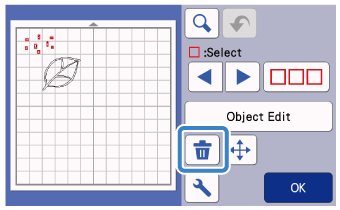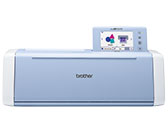SDX1200
FAQs & Troubleshooting |
How do I Create the Cutting Data (Scan to Cut Data) ?
A printed pattern or image or an original hand-drawn illustration can be scanned, converted to cutting lines for cutting/drawing with this machine, then saved as data.
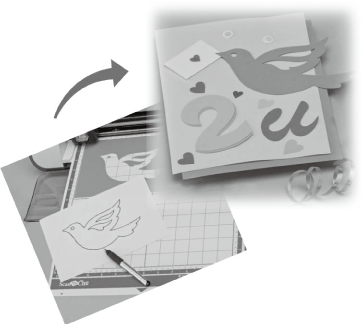
----- Procedure -----
This FAQ explains the procedure for converting illustrations drawn on paper into cut data and saving them.
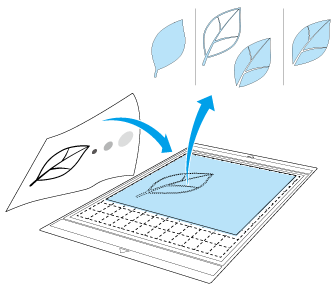
----- Preparing the material -----
When using the “Scan to Cut Data” mode, use originals like those described below.
- Patterns that are clearly drawn, with no gradation, fading or blurriness
-
Not using an extremely intricate design
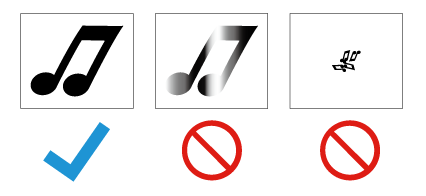
----- 1. Scanning -----
-
Touch
 , select the scanning mode, and then touch the [OK] key.
, select the scanning mode, and then touch the [OK] key.
First, test with grayscale recognition mode. If the desired cutting data is not created, test with color recognition mode.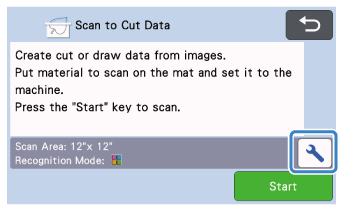
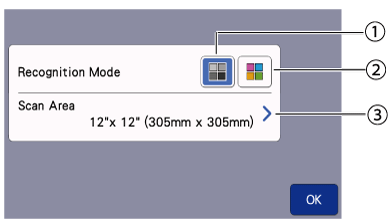
(1) Grayscale recognition mode
(2) Color recognition mode
(3) Scanning area
For details, refer to the Recognition Mode / Scanning area.
-
Attach the original to the mat, and then load the mat into the feed slot.
Lightly insert the mat into the feed slot, and press in the operation panel.
in the operation panel.
-
Press the [Start] button to start scanning.
>> When scanning is finished, the scanned image appears in the screen.
----- 2. Creating Cutting Data -----
The procedure for creating cutting data differs depending on the mode (Grayscale recognition mode / Color recognition mode).
For details on the each setting in the image editing screen, refer to the Each setting in the image editing screen.
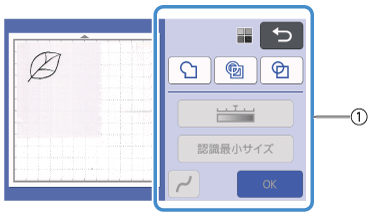 |
(1) Each setting in the image editing screen |
Grayscale recognition mode
-
Select the cutting line type (Outline detection / Region detection / Line detection) in the image editing screen.
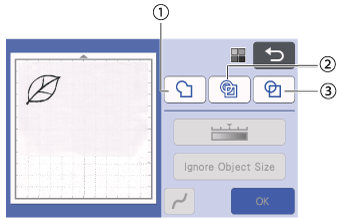
(1) Outline detection
(2) Region detection
(3) Line detection
(Grayscale recognition mode only)
Lines thicker than 1.5 mm will not be detected as lines.
-
Use the touch pen to touch
 and drag it around the screen to trim the cutting lines.
and drag it around the screen to trim the cutting lines.
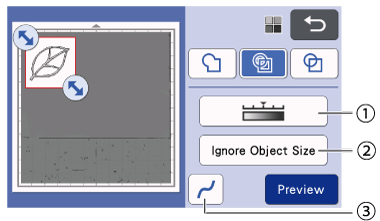
(1) Image Detection Level
(2) Ignore Object Size
(3) Smoothing Setting
-
Save data after cutting data is completed.
Color recognition mode
-
In the image trim screen, use the touch pen to drag
 to trim the image to the size to be imported.
to trim the image to the size to be imported.
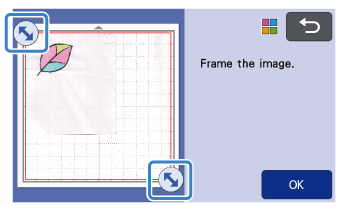
Trimming the image to the desired size can reduce the amount of time required to convert it to cutting data.
-
Touch the [OK] key to confirm the trimmed area.
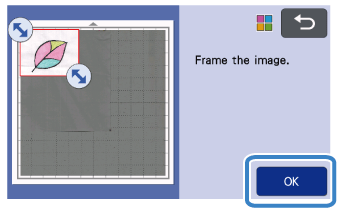
-
Select the detection standard (Outline detection / Region detection) in the image editing screen.
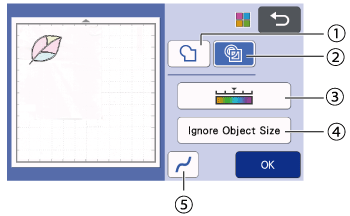
(1) Outline detection
(2) Region detection(3) Image Detection Level
(4) Ignore Object Size
(5) Smoothing Setting
----- 3. Saving Data -----
-
Select the destination where the data will be saved.
Select the desired location. For this example, select the machine.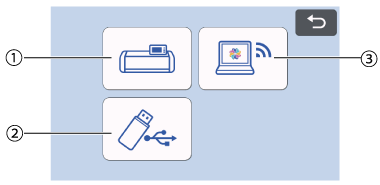
(1) Machine
(2) USB flash drive
(3) CanvasWorkspace
>> Touching a key starts saving the data. When the data has been saved, the following message appears.
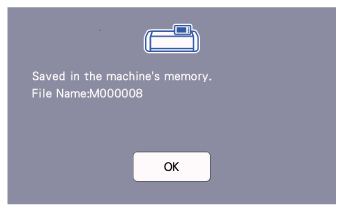
-
Touch the [OK] key to finish saving the data.
-
Press
 in the operation panel to feed out the mat, and then peel off the original from the mat.
in the operation panel to feed out the mat, and then peel off the original from the mat.
----- 4. Recalling Cutting Data -----
Saved cutting data can be recalled for cutting.
-
Attach the material for cutting to the mat, and then load the mat.
-
Recall the saved cutting data.
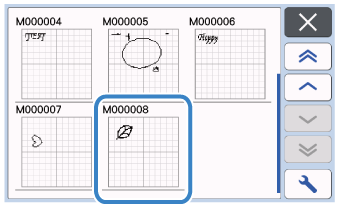
>> A preview of the pattern layout appears.
-
Touch the desired destination, and then select the desired pattern.
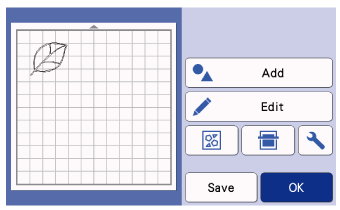
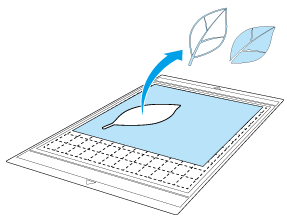
Recognition mode / Scanning area
(1) Grayscale recognition mode
The cutting data is created after the illustration is converted to grayscale. Scanning in grayscale recognition mode is most appropriate for illustrations with clear outlines or distinct brightness differences.
Processing is faster with this mode compared with the color recognition mode.
If there are adjacent objects of the same color after an illustration has been converted to grayscale, select the color recognition mode.
(2) Color recognition mode
The cutting data is created without converting the illustration to grayscale. Creating data in this mode may take some time.
* The default color recognition setting is the grayscale recognition mode.
Examples of illustrations appropriate for recognition mode:
| Examples | Recommended recognition mode | |
| Outlines that are clear |  |
Grayscale recognition mode |
 |
||
|
- Distinct difference in brightness between |
 |
|
| Similar brightness of adjacent colors |  |
Color recognition mode |
The edges of adjacent colors with the same brightness, as shown below, cannot be detected. In this case, use the color recognition mode.
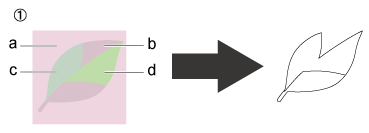
(1) “a” and “b” as well as “c” and “d” have the same brightness.
(3) Scanning area
The scanning size settings screen appears. The size of the scanning area can be selected. The available scanning area sizes differ depending on the model.
Depending on the machine model, the sizes of mats that can be used will differ. Check the [Maximum Scanning Area] under [Machine Information] in the settings screen.
Each setting in the image editing screen
<Edit key>
| Outline detection
If you wish to cut/draw along the outline of an image, select this option to convert the outline of the image to a cutting line. This is useful for saving as data an illustration drawn for an appliqué. |
|
| Region detection Select this option to detect the colored portions of an image as regions and create a cutting line around each region. Cutouts can be created using thick hand-drawn lines, such as borderlines of images or text illustrations. This option allows you to use not only cut-out patterns but the material from which portions are cut out, such as lace. |
|
| Line detection (Grayscale recognition mode only) Select this option to detect the center of lines and convert them to a cutting line. This is useful for detecting patterns consisting of multiple pieces and creating cutting lines for each piece. |
|
| Image Detection Level If the cutting lines were not correctly detected, change the number of colors to be detected. If a color that appears as a single color is detected as separate colors, reduce the number of colors. If adjacent colors with a similar brightness are detected as a single color, increase the number of colors. |
|
| Ignore Object Size Small unnecessary patterns (dotted lines, etc.) can be excluded from cutting data. |
|
| Smoothing Setting Specify the level of smoothing applied to the image outline. |
<Difference in cutting lines depending on detection standard : Grayscale recognition mode>
Example 1
| Outline detection | Region detection | Line detection | |
|
Original |
  |
||
|
Cutting lines |
 |
 |
 |
|
Finished project after cutting |
 |
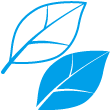 |
 |
Example 2
| Outline detection | Region detection | Line detection | |
|
Original |
 |
||
|
Cutting lines |
 |
 |
Does not apply since there are no outlines for each color in the original. |
|
Finished project after cutting |
 |
 |
|
<Difference in cutting lines depending on detection standard : Color recognition mode>
| Outline detection | Region detection | |
| Original |  |
|
| Cutting lines |  |
 |
|
Finished project after cutting |
 |
|
How to delete the unwanted spots and lines of the scanned image
Small spots and unwanted lines created during scanning can be deleted after a scanned image is converted to cutting data.
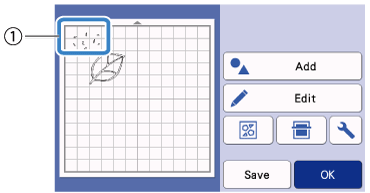 |
(1) unwanted spots and lines |
-
After recalling the cutting data into the mat layout screen,and then touch the [Edit] key.
-
Touch
 in the mat editing screen to select multiple patterns.
in the mat editing screen to select multiple patterns.
If the pattern you don't want to delete is selected, touch its pattern again to clear the selection.
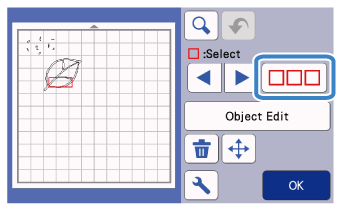
-
Touch
 for specifying an area to select the patterns.
for specifying an area to select the patterns.
Specify the area of the unwanted spots, and then touch the [OK] key.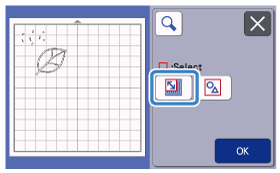

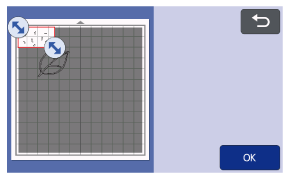
-
Touch
 to delete all of the selected spots.
to delete all of the selected spots.
